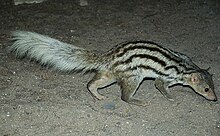
Weasels are mammals of the genus Mustela of the family Mustelidae. The genus Mustela includes the least weasels, polecats, stoats, ferrets, and European mink. Members of this genus are small, active predators, with long and slender bodies and short legs. The family Mustelidae, or mustelids, is often referred to as the "weasel family". In the UK, the term "weasel" usually refers to the smallest species, the least weasel (M. nivalis), the smallest carnivoran species.
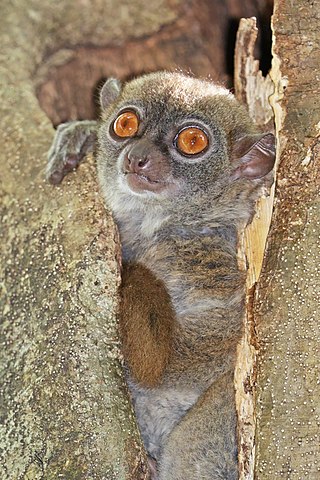
The sportive lemurs are the medium-sized primates that make up the family Lepilemuridae. The family consists of only one extant genus, Lepilemur. They are closely related to the other lemurs and exclusively live on the island of Madagascar. For a time, this family was named Megaladapidae, but the current name was given precedence since the extinct genus Megaladapis was removed from the family.

The long-tailed weasel, also known as the bridled weasel, masked ermine, or big stoat, is a species of mustelid distributed from southern Canada through much of the United States and Mexico, southward through all of Central America and into northern South America. It is distinct from the short-tailed weasel, also known as a "stoat", a close relation in the genus Mustela that originated in Eurasia and crossed into North America some half million years ago; the two species are visually similar, especially the black tail tip.

The least weasel, little weasel, common weasel, or simply weasel is the smallest member of the genus Mustela, family Mustelidae and order Carnivora. It is native to Eurasia, North America and North Africa, and has been introduced to New Zealand, Malta, Crete, the Azores, and São Tomé. It is classified as least concern by the IUCN, due to its wide distribution and large population throughout the Northern Hemisphere.

The weasel sportive lemur, also known as the greater sportive lemur, weasel lemur, or greater weasel lemur, is a species of lemur native to northeastern Madagascar. Its habitat includes rainforests and tropical rainforests. Its dorsal side is a reddish-brown colour, and greyish brown ventrally. Its colour darkens towards the tip of its tail. Individuals weigh from 0.8 to 1.2 kg It has long, soft fur. Its body length is approximately 22–30 cm (8.7–11.8 in) and a tail length of 23–27 cm (9.1–10.6 in).

Grandidier's mongoose, also known as the giant-striped mongoose or Grandidier's vontsira, is a small carnivoran that lives only in a very small area of southwestern Madagascar, in areas of spiny forest vegetation. It is pale brown or grayish coloured, with eight wide, dark stripes on its back and sides. Grandidier's mongoose is larger than the related broad-striped Malagasy mongoose, G. fasciata, and its stripes are not as wide. The species is named after Alfred Grandidier.
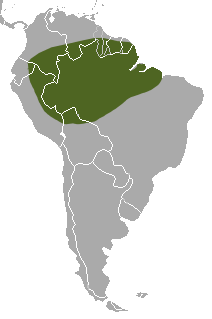
The Amazon weasel, also known as the tropical weasel, is a species of weasel native to South America. It was first identified from a museum specimen mislabelled as coming from Africa, hence the scientific name.
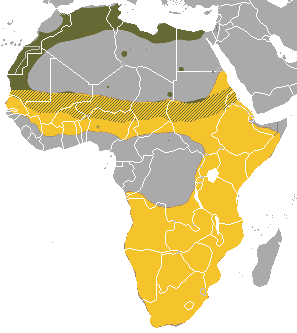
Ictonyx is a genus in the family Mustelidae (weasels). It contains two species:

A grison is any mustelid in the genus Galictis. Native to Central and South America, the genus contains two extant species: the greater grison, which is found widely in South America, through Central America to southern Mexico; and the lesser grison, which is restricted to the southern half of South America.

The Siberian weasel or kolonok, is a medium-sized weasel native to Asia, where it is widely distributed and inhabits various forest habitats and open areas. It is therefore listed as Least Concern on the IUCN Red List.

Galidiinae is a subfamily of carnivorans that is restricted to Madagascar and includes six species classified into four genera. Together with the three other species of indigenous Malagasy carnivorans, including the fossa, they are currently classified in the family Eupleridae within the suborder Feliformia. Galidiinae are the smallest of the Malagasy carnivorans, generally weighing about 600 to 900 g. They are agile, short-legged animals with long, bushy ringed tails.

The small-toothed palm civet, also known as the three-striped palm civet, is a viverrid native to dense forests of Southeast Asia, from the Assam district of India to Indochina and the Malay Peninsula and on Sumatra, Bangka, Java, Borneo, and numerous small nearby islands of Indonesia.

The Colombian weasel, also known as Don Felipe's weasel, is a very rare species of weasel only known with certainty from the departments of Huila and Cauca in Colombia and nearby northern Ecuador. Both its scientific and alternative common name honours the mammalogist Philip "Don Felipe" Hershkovitz.

The Patagonian weasel is a small mustelid that is the only member of the genus Lyncodon. Its geographic range is the Pampas of western Argentina and sections of Chile. An early mention of the animal is in the Journal of Syms Covington, who sailed with Charles Darwin on his epic voyage aboard HMS Beagle.

The broad-striped Malagasy mongoose or broad-striped vontsira is a species of Galidiinae, a subfamily of mongoose-like euplerids native to Madagascar. The species contains two known subspecies: Galidictis fasciata fasciata and Galidictis fasciata striata.
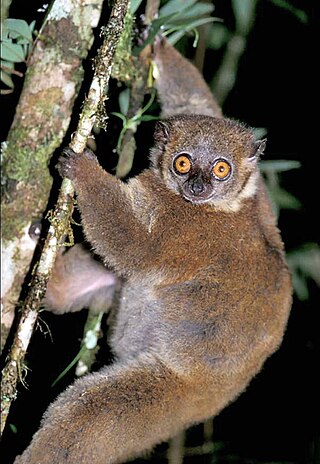
The small-toothed sportive lemur, or small-toothed weasel lemur, is a primate species in the family Lepilemuridae that—like all extant lemurs—is endemic to Madagascar. The species lives in dense rainforest in southeastern Madagascar, and can be found in Ranomafana and Andringitra National Parks. Described in 1894, it was considered either a subspecies or taxonomic synonym of the weasel sportive lemur throughout most of the 20th century. Phylogenetic studies not only support its species status, but also suggest that it is the only eastern Malagasy sportive lemur that is more closely related to western than to other eastern species.

Salanoia is a genus of euplerid carnivoran with two currently described species found in Madagascar. They are mongoose-like, which is reflected in the older versions of their English names, for example brown-tailed mongoose which is now called brown-tailed vontsira. The name Salanoia is derived from salano, one of the vernacular names for Salanoia concolor.

Stink badgers or false badgers are the species of the genus Mydaus of the skunk family of carnivorans, the Mephitidae. They resemble the better-known members of the family Mustelidae also termed 'badgers'. There are only two extant species – the Palawan stink badger or pantot, and the Sunda stink badger or teledu. They live west of the Wallace Line; the Sunda species on islands of the Greater Sunda Islands, being Sumatra, Java, and Borneo; in Borneo the badger is found in Indonesia, Malaysia and Brunei. The Palawan species lives in the Philippine island of Palawan as well as the islands surrounding it.

The Japanese weasel is a carnivorous mammal belonging to the genus Mustela in the family Mustelidae. The most closely related Mustela species is the Siberian weasel. Its taxonomic species name, itatsi, is based on the Japanese word for weasel, itachi (イタチ). It is native to Japan where it occurs on the islands of Honshū, Kyūshū and Shikoku. It has been introduced to Hokkaidō and the Ryukyu Islands to control rodents and has also been introduced to Sakhalin Island in Russia.
Mustela aistoodonnivalis, the missing-toothed pygmy weasel or Sichuan weasel, is a species of weasel that inhabits mountains in the Shaanxi and Sichuan provinces of China.
